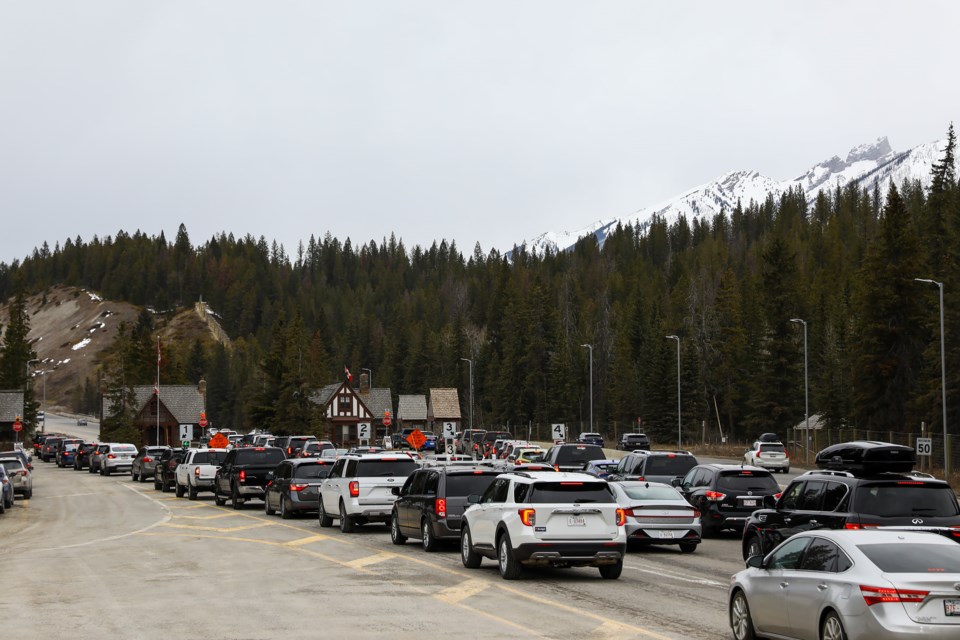The Town of Banff will investigate the feasibility of a parking reservation system within the tourist town to ease overcrowding and congestion during peak summer days.
Discussion is in the very preliminary stages of what essentially would amount to a cap on private vehicles, but council voted 4-2 to at least examine the possibility and report back on findings during the annual service review at the end of 2024.
Coun. Ted Christensen said gridlock and traffic congestion are hurting the experience visitors are having in Banff and negatively impacting residents.
“We need a different system for regulating vehicles in town,” said Christensen, who lost his bid earlier in the day to consider hiking visitor paid parking fees.
“It’s not that we’re going to do it tomorrow, but we’ve got to check it out. We’re at capacity, or over capacity sometimes. We’re looking for bold moves, we’re in a critical spot."
Parking reservation systems are becoming increasingly popular around the world as technology improves.
Parks Canada already uses a parking booking system in Ontario’s Bruce Peninsula National Park. Time slot reservations allow travellers to plan in advance, and once the parking is fully booked, there is no other access at that time to the popular destination located in the Niagara escarpment.
In the United States, Yosemite National Park is piloting a new vehicle reservation system in 2024, to be known as the “Peak Hours Plus'' system and running for select dates during busy times from April through October.
During discussion on the future of the downtown pedestrian zone Dec. 18, many residents called for some type of quota on the number of private vehicles allowed in the townsite, aside from residents and visitors with hotel reservations.
Mayor Corrie DiManno and Coun. Grant Canning were opposed to investigating the feasibility of a comprehensive parking reservation system at this time, while Couns. Barb Pelham, Kaylee Ram, Hugh Pettigrew and Christensen were in favour of getting more information.
“I do think it’s time to be creative. This isn’t binding and I would like to see what comes forward,” said Ram.
DiManno said the Banff townsite is a service centre for visitors, which is mandated by Parks Canada.
“Something we learned during the pandemic is we are right off the Trans-Canada Highway and we need to remain open as an essential service – gas stations, grocery stores,” she said.
A parking reservation system could make more sense if there was mass transit between Calgary and Banff, said DiManno, as well as more public transit throughout Banff National Park.
“We would need to build up our mass transit options so people have other ways to get here frequently, reliably, and affordably before coming in with something like this,” she said.
“I think it’s signalling a message that I am fearful will be misinterpreted.”
Concerned about the message such a move would send to visitors at this time, the mayor said she was grateful many visitors have changed behaviour when it comes to transit and active modes.
“Folks have embraced our message of please park and take transit, or just take transit to begin with,” she said
“We’ve had record numbers with On-It and we have record numbers with Roam system-wide.”
During Banff’s service review on Dec. 13, administration gave an overview of the successes and challenges associated with traffic and parking management, noting Banff’s road system is beyond capacity and a further shift away from personal vehicles throughout the townsite is needed.
Officials say the train station intercept lot is full by 1 p.m. on most summer days and options for day visitors are becoming limited, while downtown parking is at capacity at peak times, resulting in congestion as vehicles circle looking for parking.
Adrian Field, the director of engineering for the Town of Banff, said up to 47 per cent of vehicles travelling up Mountain Avenue to tourist attractions like the gondola and hot springs are turned around when the parking lots are full at peak times.
“That's hundreds of vehicles per hour… If we can somehow get those folks to not do that and get on a bus instead, then that road system would function a lot better than it does.”
That said, there have been successes, including significant increases in sustainable transportation mode choices.
According to the municipality’s statistics, fare-free rides of Banff locals on the local Roam routes hit 400,000 this year and local Roam ridership has hit a record 1.5 million so far this year, with half of that in July and August.
Field said sustainable modes – transit, walk and cycle etc. – now account for 38 per cent of all Bow River crossings, up from 26 per cent in 2019, and because of that vehicle volumes across the bridge are down 17 per cent.
“When folks say congestion appears to be better, that’s why, and the reason is because of the investments in transit and sustainable modes,” he said. “Those things really work.”

.jpg;w=120;h=80;mode=crop)

